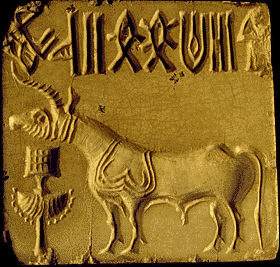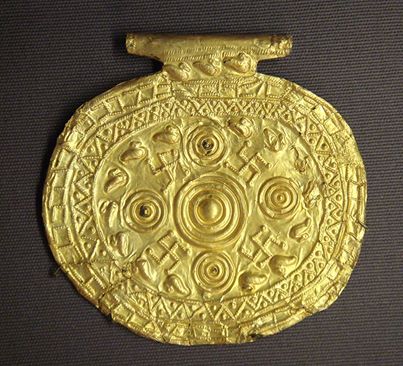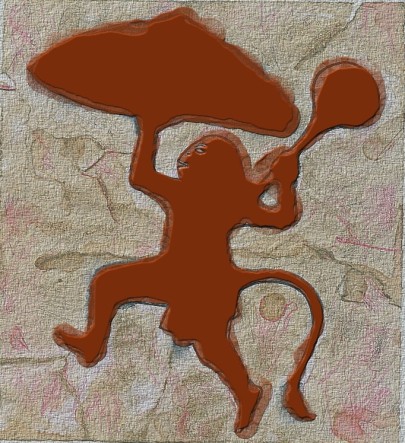Archive for category Language of Morality
A Hindu-centric World-view
Posted by Kalicharan Tuvij in Language of Morality on May 12, 2017
Abstract:
A linguistic framework for a Hindu world-view, geocentric about the Indian subcontinent, is presented. This world-view, in all likelihood widely prevalent among Astika Wanderers since time immemorial, is drawn upon here by available empirical detail, and ably captures the envisioned entanglements of Devata-s with the mundane realm.
Discussion:
Figure-A
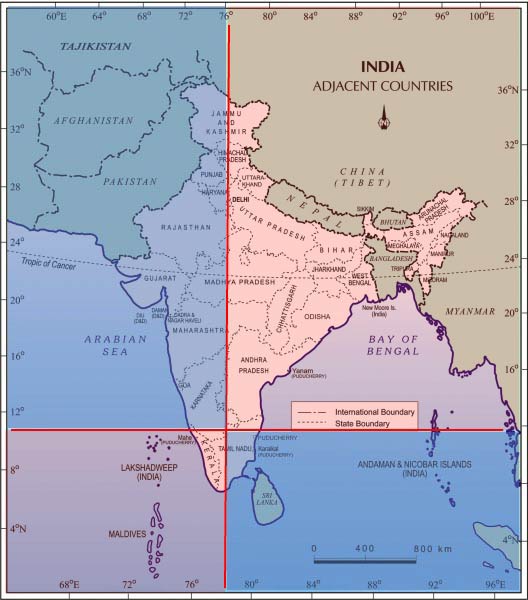
In Fig-A two red lines are shown drawn across the India map:
A vertical line running at Longitude [77.5 ± 1.0°], a horizontal line at Latitude [10 ± 1.0°]. Their intersection point – just north of Kerala and Tamilnadu, and south of Karnataka – is earmarked here as the Origin point, KumAra-Granthi. Quadrants falling in the left nADI of bhArati are shown in red overlay, while quadrants falling in the right nADI of bhArati are shown in blue overlay.
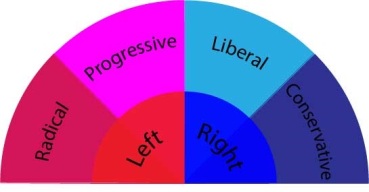
The red regions are primarily Devis’ Kshetra-s/domains, the blue ones are primarily Devas’ Kshetra-s. In Deva-Kshetra, societies evolve as conservative, industrial, male dominant, and tend to practise systematized religions (Deva oriented). Devi-Kshetra cultures evolve as socialistic, creative, female oriented, and practise diverse localized religions (Devi oriented).
These influences also culminate in a specific Triangular representation of India:
1) KaumAra-vertex (South); Prototypical
2) Ashvina-vertex (West); Sarasvati cultures
3) Hanumat-vertex (East); GAnga cultures
Figure-B
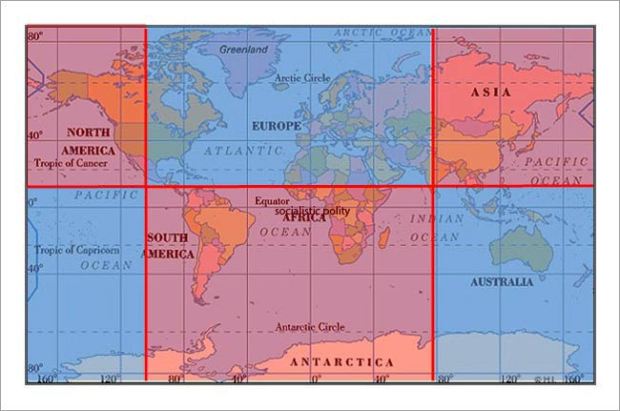
Next, in Fig-B, the same red lines are extended beyond the subcontinent to throughout the globe.
China, big chunks of Russia, South America, South of Africa – fall in the red quadrants, whereas Europe, Mid-East, Australia, etc come under the blue quadrants. Now, societies and cultures beyond the Indian subcontinent can hardly be classified as Astika (subscribing to Hindu world-view) – so the modes of religions are not Hindu – yet other indicators (e.g. socialist/communist proclivity of Red, and liberal/conservative of Blue, etc) fit in perfectly with the model.)
We clearly also have one more Kumara-granthi- near Mexico (where the red lines intersect again). Unsurprisingly, this is the birth-place of Kumara manifestation, the great old God – Kukulkan. (To be honest though, quite surprising)
The North American countries show equal areas between Red and Blue, though not in an as diversified manner as India.
India’s diversity – with holistic specialization – can be a hidden gift to the nation, but if not properly handled by policy influencers can only result in genetic load (as is the case presently) manifesting into chaos and self-destruction.
On the Triangle Linguistic-Representation of India:
1) KaumAra-vertex (South); prototypical
2) Ashvina-vertex (West); Sarasvati cultures
3) Hanumat-vertex (East); GAnga cultures
These are the three orthogonal centres of core-competencies that through interactions amongst themselves create the whole Astika homeland. Linguistically these are the centres of Dravidian, Sanskrit, and Munda families respectively, all other regions in-between being “Krigian geostatistical” mix of the three.
So even as the KaumAra-vertex can be somewhat seen as the first among equals, the mutual interactions among the three are more on the lines of contemporaneous. For example, the mandAra parvata “used” in Samudra Manthana (a Southern event) is located in the Bihar-Jharkhand region (near Hanumat vertex).
Another way to understand this is with the analogy of Antenna: the three vertices constitute an antenna array like system — creating a space inside (the triangular region) where internal communication (without interference) happens, and a space outside where signals are transmitted.
The three vertices, however, are far from being alike: as discussed earlier, the Southern vertex constitutes of both deva & devi kshetra-s within a rather condensed territory. The other two centres — Ashvina & Hanumat are attuned to deva and devi influences respectively and have a lot of freedom for space and movement.
Ashvina vertex — being deva oriented, outwards looking, and male dominant – was responsible for taking the lead in the codifying of Astika knowledge system in the form of Veda. Both the Veda and the “universal” language it was expressed in were built bottom-up in an industrial-like fashion, even as these truly belonged to the time immemorial inter-communication within the triangle of the insiders’ space.
P.S.
There is also the tradition of Veda mUrti-s (largely “off-the-radar” and undocumented, though once acknowledged by the Maharashtrian scholar Sri Hemadri in his ~1300 AD work Chaturvarga Chintamani) where each Veda itself is known and worshiped as a deity with a unique face:
Rg-veda: रासभाननः (Donkey face)
Sama-veda: हयाननः (Horse face)
Yajur-veda: अजाननः (Goat faced)
Atharva-veda: मर्कटाननः (Monkey face)
So, even as Ashvin koNa took lead in putting expression to the Veda, this tradition indicates that –
1) the Rk & the sAman come originally from the Ashvin-vertex (donkey and horse both belong to equus genus).
2) Atharvan comes originally from the Hanumat-vertex.
3) Yajus comes originally from the KaumAra-vertex (अज understood as “prototypical”; आदेः जायते. Moreover, the goat is also considered as the most original face of Kumara – “the six-faced” – of his all six faces.).
Bālāji, the Lord of Tirupati : meaning of the name
Posted by Kalicharan Tuvij in Language of Morality on February 11, 2016
Consider two words: बालाजी and रामाजी.
जी is honorific. Also, बाला and रामा both are in vocative.
Both बाल and राम, fundamentally mean: “male”
So बालाजी (as well as रामाजी) means:
“He”
(with a capital h)
Of course that would be Lord Vishnu here.
The actual accents – how people down South here – pronounce बालाजी supports what I said.
The moral of the story:
a) Sanskrit lost accents.
b) Sanskrit lost varied use of vocative.
c) Tradition is therefore, as an authority, higher than a loukika bhAShA, and shouldn’t be doubted so easily.
*******************************************************************
रामा as a vocative is in universal use in प्राकृतम् (i.e. not only Hindi) throughout Northern India. And this is indeed naturalistic, evidenced by other uses (in a-ending nouns) such as यारा (vocative) for यार (male friend), and therefore is not borrowed.
regarding बाला,
Again, in the North we have:
बालमा (voc.) and बलमा (voc.) for बालम (male friend) and बलम (male friend).
balls : testicles, ball : round object, ballsy : courageous, bald : no hair on (round) scalp (thus exposed), bull, bell, etc.
Hindi: बल manly power, बाल hair growing on (round) scalp, बाला bangle (round), बाली earring (round), बेल a round fruit, बाली Sugreeva’s powerful brother, बैल, etc.
In fact, shaving head at Tirupati could be related to the word root.
जी following a vocative is easy to understand. But the deeper question is indeed of the original uses of vocative that modern Sanskrit has lost. We will come to this point later but for now, let us understand बाला as the vocative qualifying जि: the nominative to produce बालाजि:, or बालाजी: the nominative.
To summarise, I must emphasise again that बालाजी means “He” / पुंदेवता (not related to Bala-Krishna as speculated by some).
The historical questions are highly irrelevant, since the “He” could have been any male deity, theoretically. The exchange of deities, among different dhārmika orientations, in the long histories of temples is a commonly observed phenomenon all over India. There is more unity among dhārmika traditions than what is acknowledged superficially. The point is, the spiritual power remains the same. However, this has not stopped many trouble mongers from peddling unnecessarily, without proper context or acumen, in such matters.
The validation of the meaning “He” (पुंदेवता) comes in the existence of quite a few Hanumāna temples (in Rajasthan) that are also called as Balaji temples, and also at least one Sūrya temple in Madhyapradesha again called a Balaji temple.
*******************************************************************
बल (= वल) can be said to be the root word here. By applying different vowels and semivowels we get all other instances (including yavana words such as vale, valley, wall, ball, bull, etc etc).
One of Indra’s enemies is known as वल (also बल). वल, just like वृत्र, is a power of असत् that encompasses, encircles, and isolates realms. Since Vaidika words are self-referencing, and original, the purest meaning of वल is this: circle, or something circled. An immediate example: वलय.
The next purest instance I can think of is the vel of vel-murukan. This vel is mystically understood to be the piercer of the barrier (here, वल). From here we can see बल also getting its meaning: manly power, or even the male organ. So we have बैल etc.
In my view, therefore, in the North-West of India (or likely in Maharashtra itself) we had the word mutation of वल as वल and बल (e.g. in Punjabi: वल्ले-वल्ले and बल्ले-बल्ले) and there onwards it spread to IE worlds. However, before the mutation, the word had its origin in the South as वेल.
Name nArAyaNa नारायण : A truer understanding
Posted by Kalicharan Tuvij in Language of Morality on April 29, 2015
Summary:
Calling shrI viSNu instead as “nArAyaNa” is a serious disrespect, even if borne out of ignorance, towards shrI viSNu: Narayana is a proper name of shrI sUrya, a Vedic god. Narayana as an epithet of shrI viSNu, no problems, but as a proper name itself — is a huge denigration of both shrI viSNu and Vedic Dharma.
*********
nAra means waters, also means woman, mother.
And AyaNa : let us just say, it means “refuge”.
Indeed, we are not talking about “Samudra” (the Father) here, instead we are talking about Apah, nAra, Mothers’ expanse.
Who is the first born of Mother? In Shaiva tradition it is gaNesha, and equivalently in Vedic it is shri agni, also called “apAma-napAta” i.e. waters’ child.
Surya is the highest deity in the span of shri agni the aSTa-vasu and therefore understood as the very first manifestation of Creation from Mother’s womb of Infinity. The first God that we can understand in terms of forms and worship accordingly. The overlord, as well as the guide, of all Creation.
shri viSNu, a “composite God” like shri agni, has a still far greater scope (pervading virtually everything within it) than even shri agni, and therefore He obviously “contains” Surya also within Himself (in the infinite unbroken continuity of His being).
In this way He can assume any of the various deities’ names as His adjectives. This is not the same as calling His proper name as something which is a proper name of some other deity.
However, the avatAra who can indeed take Narayana as His proper name is the Avatara of Lord who comes in the Surya-mode of shri viSNu.
And that would be, shri rAma. Ever heard of “rAmAyaNa”? The sacred book that is the refuge of all mortals? Ramayana is Narayana.
Does Rama-Narayana ring a bell? yes?
Does Krishna-Narayana ring a bell? No?
***********
If we try go deeper into the famed “nara, nArAyaNa, hari, kriSNa” found in the purANa-s, by comparing with the mahA-mantra “hare kriSNa hare kriSNa..” we find that hari and kriSNa are common to both listings.
nara is nothing but the divine human inflated within us. So we are left with the word nArAyaNa being same as the name rAma of the mahA-mantra.
shri rAma – the superhero of rAmAyaNa, when exhausted in the war against rAvaNa, was advised to worship shri sUrya (in Aditya stotram) in order to regain strength by tapping into His very own source (sUrya).
But do I mean then that shri rAma was an incarnation of sUrya deva, not of shri viSNu?
No. karNa in the mahAbhArata was a manifestation of sUrya. But when we talk about avatAra, we say: “shri rAma was viSNu’s avatAra in the mode of sUrya.” We can, otherwise, find many similarities between karNa and shri rAma. But karNa wasn’t an avatAra. People in the anga-pradesha even to this day remember the rule of karNa as fondly as the rest of Hindus remember the rAma-rAjya.
***************
rAma nAma and nArAyaNa nAma:
Many Hindus cultivate a habit of using the rAma nAma frequently, such as by greeting each other using the nAma (“Jai shri rAma”, etc). The secret behind this is no secret at all: we do it so that the nAma is on our lips for one final time again when we are about to die.
RAma is the shortest path to what Vedanta knows as “moksha”. I equated rAma nAma to nArAyaNa earlier in this thread. Notice the “rA” sound common to both (same that occurs in surya who is bhArata-bhAratI).
So, yes, we are not talking about finite entities here at all. We are talking strictly about the “Infinites”, the “its” here.
Read the following carefully to understand this:
Let me explain the idea using the material analogy (a valid method). Let us then talk about the material space (bhaga-AkAsha) that we are surrounded with. How do we characterise this space?
Clearly, bhaga-AkAsha is attribute less. Yet we say, “here we have so and so length, so and so width, and so and so depth”. Thus, we still are able to talk about the infinite in terms of “length”, “width”, and “height” which are very much finites. This is known as understanding the infinite using the language of finite.
In surya who is bhArata-bhAratI, the bhArata-component is an aMsha of Sri Indra, while the bhAratI-component (a mighty Devi as well) is an aMsha of Narayana.
In this way, to the Vedic Rsis all knowledge was expressed in terms of the aindra (Vedic Sanskrit is called Aindra): Indra classifies the finites by “divide-and-rule”, but also makes out the infinites using the Aindra reception (also known as “inducing”, “induction” etc – these words are rooted in Indu and Indra).
To come back to the original analogy, what do the Aindra description of bhaga-AkAsha (material space) using length, width and depth (there could be actually many more such finites such as position, momentum, energy, etc) tell us?
This description by the three finites tells us about the existence of three Infinites within the space. What are their names?
****
Let us now come out of the analogy. The point I tried to demonstrate here was that: “there are more than one Infinite”. There are more than one States of what Vedanta calls “mOkSa”. And Narayana is the deity, the “it”, who is the closest such state. Narayana is therefore also the first deity of this class encountered by our specially talented ancestors, the Rsis, when they were on their “straightest path”, when they toiled hard to pave the way forward for humanity.
The names nara, nArAyaNa, hari and krishNa – spell out a very important formula (though still not the whole of the sanAtana-truth), and all these four names are seen on an equal footing, yet they are different from each other: nara is all the finite worlds combined, whereas the three others are three different Infinites, three different “its”.
I hope I made myself clear here.
****
On the intellectual plane, let me point out that the Rsis nara, nArAyaNa, hari and krishNa belonged to Satyuga (ref. MahAbhArata). In satayuga shri viSNu doesn’t incarnate: there is no need for it.
So these four were Rsis who specialised in four very important modes of shri viSNu. This is how these names today are quoted more in the context of Vaishnavism. Though, these four names, and the deities behind them, can in a still valid way appear in Shaiva or any other Dharmika paradigm as well. Thus, for example, we see Swamy Satya-narayana’s vigraha (in the ancient and important satya-narayana temple in Annavaram, Andhra Pradesh), though still considered on some kind of equivalence with shri rAma (who is believed to be the kshetra-pAlaka of the said temple), is also traditionally considered as “belonging” to all the three paradigms (also called deities): Shiva, Vishnu and BrahmA.
Understanding The Indu-Saraswati Seals
Posted by Kalicharan Tuvij in Language of Morality on March 8, 2014
The Indu-Saraswati seals of archaeological find provide a very keen insight, as also some hard evidence, into the deep Vedic roots of the (H)indu Civilization. The connection between the two: Vedic literature, and archaeological find: is apparently indeed natural, but it could be asked here- why, then, the connection has not been immediately evident to everyone? The answer to this question has more to do with a bad approach to the problem, than the “purported” mal-intent of some to distort an otherwise purely academic discourse.
The problem with the approach has been that it misconstrued the Vedic corpus as a “given” and an accessible resource, while the seals (and the other finds) were “meant” to be something inscrutable, mysterious that needed decoding. The reality, however, turns out to be just the opposite:
The seals- simple creations of artisans- are actually the “given”, whereas it is the Vedic texts that needed the decoding.
This problem is more a home-grown one than a conspiracy theory pointing to some foreign stake-holders:
Hindus have failed to understand the Vedic thought in its true light, and under the spell of relatively recent paradigms such as Vedanta continue to see the Veda as merely something of a ritual-book, karma-kANda. The Vedic Sanskrit (in which the Veda is written) is far richer than the Classical Sanskrit (in which the Vedanta is expressed), and this fact alone- if not anything else- should have alerted them that the quality of content should therefore also be far richer in the Vedic than in the post Vedic.
Anyway, enough on this already; here we will be discussing some of the depictions in the seals alongside an understanding from the Vedic view-point. For the conceptual framework- not much is explained here- the reader is advised to consult other posts of this blog-site.
ADITI and The Four Realms (lokA)
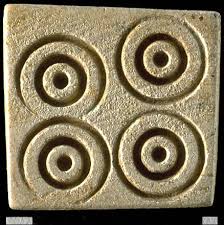
This depiction relates to the Four Realms of Aditi, and the three-fold nature of each Realm is represented by three concentric circles in each of the quadrants. The circles (realms), naturally, also have contact points with the adjacent realms. “Asat” is the state of these realms when they are isolated from each other, whereas “Sat” is the state when these realms communicate with each other via the four contact points between them.
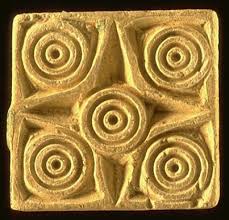
This depiction is a secondary variation of the first one. In addition to the four realms, there is one more shown now in the center, indicative of the “Immortal” consciousness which is placed center of all the realms and their influences.
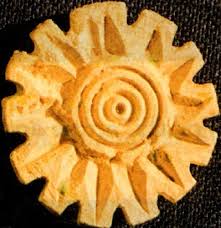
This seal focuses only on one realm, and as before there are three concentric circles, and also the fourth making a boundary giving effect of emanating Sun-rays. The circles therefore can also be seen as some kind of solar deities, also called Aditya-s, or the children of Aditi.

This one is still another variation of the Four Realms, idealized to the extreme by the use of plain straight lines. This symbol is known as Swastika and is the most sacred (certainly more than the AUM) symbol of Hindus.
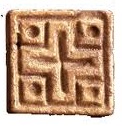
This one is yet another idealized variation of Realms. The circles are not completely abandoned (not even in the present day Swastika) and are depicted as simple dots.

In a related symbology, this seal depicts Vedic God Yama having buffalo-horns (buffalo is His vAhana) for His crown. This goes against the earlier speculations about the figure being that of Shiva/ Rudra, though very few know about the close proximity of the two Vedic Gods Yama and Rudra. As a corroborative we can see four animals surrounding the kingly God: a Tiger (on His left bottom), an Elephant (on His left top), a Rhino (on right top) and a Buffalo (on right bottom). These four animals denote (in the postVedic mythology) the “contact points” between the four realms. Moreover, their sequencing is also right: Tiger is opposite Buffalo (Yama’s own place), and Elephant is opposite Rhino.
Finally, this one, as also discussed earlier in this post, depicts the Vedic God Vayu as an exotic imaginary animal, who is “made up” from an artistic synthesis of many different animals (yes, horse included), receiving Soma juice (soma pavamAna) from an equally exotic “Soma-juice-blender”-cum-“Sacrificial-altar” where the acts of sacrifice (Vedic Yagna) and the receiving of Soma-juice are simultaneously performed and effected. This is also how the communication lines are established between the two (of the four) realms: Heaven (Dyo) and Earth (Prithvi).
Now let us look at the above pendant. Looks like yet another Vedic depiction of Swastika and Aditi’s Realms ? Well, only, this is from Bolsena, Italy ( Etruscan, 700 BC at the farthest). The Indu-Saraswati seals discussed here, however, belong to 3000-2000 BC window. So, the pendant borrows from the Indu-Saraswati which is the source– if we go by the time-scales involved, by the richness and the variety evident of the original design as discussed earlier, and also by how this goes right to the heart and crux of the Vedic thought; finally, the stickiness and exact similarity between the two confirms a faithful transfer of religio-spiritual beliefs (normally associated with actual migrations/invasions of people).
There is more to say, no doubt, but let us leave it here for now.
REFERENCES AND FURTHER EXPLORATION:
4. THE RAMAYANA AND THE ROOTS OF PRE-CHRISTIANITY CIVILIZATION OF ITALY
PanchaJana पञ्चजन and The Five Yoga-s
Posted by Kalicharan Tuvij in Language of Morality on November 4, 2013
From Vedanta वेदान्त generally one comes to know about the four Yoga-s योग as spiritual disciplines that can be practiced together or independent of each other. Vedanta, however, has only made a collection of the already existing Yoga-s: bhakti भक्ति, karma कर्म, rAja राज, and jnana ज्ञान.
Firstly, Vedanta did not create them.
Secondly, even then, one Yoga is missed out: the Yoga of “Artistic pursuits” (for the lack of better word).
The only place where these are talked about (and indeed discovered) is in the Veda, where the Five Yoga-s are called “The Five Tribes” (PanchJana/ पञ्चजन), where, the evolved mankind is thought of as “components” made from five kind of people: The Athlete (<Karma), The Lover (<Bhakti), The Artist, The Thinker (<Raja), and the Sage (<Jnana). Every Arya (Hindu) is invited to fully evolve himself using all these modes, together.
This is aligned to the way by which we can implement Dharma धर्म into the practical/ day-to-day aspects of our lives, something that holds further promise for our progress.
¿”The Yoga of Artistic pursuits”? / “A FIFTH Yoga?”
Veda doesn’t use too many labels, it only talks in terms of its Devatā-s. One can say, Veda is the BigBang consciousness where all knowledge, all awareness, reside in a unitary language.
We can call this “fifth” Yoga, and what comes to my mind, the “Vrata Yoga” व्रत योग. Vrata means here “starting something with a resolve of completing it”, i.e., “the part” containing the “whole” by the way of harmony. Indeed, Art fits the bill, but there is surely a greater scope.
These five Yoga-s, or the modes, are gifts from the Deva-s of Swarga स्वर्ग: Sūrya सूर्य (Jnana), Indra इन्द्र (raja), Mitra मित्र (Vrata), Marut मरुत (Bhakti), and AśviniKumar अश्विनीकुमार (Karma). Swarga has two ends (like any other Lōka): one is presided over by Sūrya and the other by AsviniKumar.
One can say, Surya is very much related to Indra, and Asvins (AsviniKumar) very much related to Marut.
PanchJana and Pandava-s
In Mahabharata, Kunti (wife of king Pāndu) wanted the very best of humans as her children, with the use of the vardāna (boon) given to her by Rsi Durvāsā. She (along with the other queen, Mādri) was blessed with “five sons” known as “Pāndava-s”.
Now, the thing with the Mahabharata is that here we get to see the total range, from the very divine to the vilest; purest of knowledge, mixed with even the worst of ignorance. And a lot of grey shades, to add on to this.
Rsi Durvāsā’s vardāna was perfect; Mitra, Indra, Maruta and AsviniKumar — gave their amśa-s (parts) to take birth (as manifestation only, and not Avatāra) as: Yudhisthira, Arjun, Bhim, and Nakul – Sahdeva, respectively.
Of course, people of the Mahabharata age, due to some ignorance (no Satyuga, remember) called Yudhisthira to be from Dharma, and Bhima from Pavan, since Mitra was as good as forgotten by that time, and Marut also got converged into a separate Vedic Deva, Vayu. (confusing mostly because Lord Hanuman, a Janus-God, was known to be from both Marut and Pavan/ Vayu). On the other hand, Dharma as an idea had become the prerogative and authority of the king (means, no separate Judiciary), by that time, and indeed, in Veda it is Mitra who is the ruler of Swarga (not Indra), so Yudhisthira was conceived to be “the best ruler of men.” {however, Dharma in general relates to all the five modes together, and Marut in particular}
Mahabharata is rich, and complex in its history telling. Now, in the “Pāndava-s”, AsviniKumar manifested as a twin (since Asvins are twins). So it seems to break the notion of PanchJana.
Though, actually not, the real fifth in this fivesome was KarNa, the son of Surya from Kunti.
Mahabharata is mind-boggling, yes?
The Pāndava-s became the “five modes” to support progress by connecting to the divine in Krishna. One may ask, however, how come Krishna was an Avatār, but the Pāndava-s were not?
One can only say: if, for example, Vishnu incarnates as the Indra mode, then it is Avatāra; equally, and equivalently, the same thing can be said as: if Indra incarnates in the Vishnu mode then it is an Avatāra. Else, the manifestation could well turn out be an out-of-harmony power, Asura (not a pejorative in the Veda; it is like “Titan” may be).
Tryambaka Ishvar Rudra
Posted by Kalicharan Tuvij in Language of Morality on October 9, 2013
Before understanding the meaning of “Tryambaka” त्र्यम्बक, let us consider the following Rica रिचा, श्लोक (incidentally one of the most powerful mantra-s) from the RgVeda:
RV 2.41.16 (to Devi Saraswati)
अम्बि॑ऽतमे । नदी॑ऽतमे । देवि॑ऽतमे । सर॑स्वति । अ॒प्र॒श॒स्ताःऽइ॑व । स्म॒सि॒ । प्रऽश॑स्तिम् । अ॒म्ब॒ । नः॒ । कृ॒धि॒ ॥
ambitame nadītame devitame sarasvati | apraśastā iva smasi praśastim amba nas kṛdhi ||
Translation: “Among all mothers (ambi-s), among all rivers, among all Devis, O Saraswati, thou are the best! O mother (amba), make us – the ignoble- full of renown.”
Here, both ambi अम्बि and amba अम्ब have been used to mean “mother”. So, amba means: mother -common noun- not Mother, but mother; and much more than that:
“womb” can be seen as coming from amba.
It also denotes the “waters” realm of Mother (Antariksha; Space).
That’s where ambā (“watery”/ “spacious”) comes from, as well as ambikā (ambi+kā; fem.).
Hence, ambuja (ambu+ja) means: “water-born”; ambar (amba+ra) means: antariksha, ākāsha.
And that’s why ambak (amba+ka; masc.) means: “of mother”. This is the only meaning Veda knows of, verily, as in this exquisite Rica (the famed Mahāmrityunjaya Mantra) for Rudra.
RV 7.59.12:
त्र्य॑म्बकम् । य॒जा॒म॒हे॒ । सु॒गन्धि॑म् । पु॒ष्टि॒ऽवर्ध॑नम् । उ॒र्वा॒रु॒कम्ऽइ॑व । बन्ध॑नात् । मृ॒त्योः । मु॒क्षी॒य॒ । मा । अ॒मृता॑त् ॥
tryambakam | yajāmahe | sugandhim | puṣṭi-vardhanam | urvārukam-iva | bandhanāt | mṛtyoḥ | mukṣīya | mā | amṛtāt
Translation: “I worship thee, the Three-mothered (Tryambaka), of pleasant odour, the giver of good health. Liberate me unto Immortality even as the gourd fruit is freed of its shell (i.e., when death comes).”
So, त्र्यम्बक = त्रि + अम्बक, Tryambaka = tri (three) + ambaka (of mother)
Tryambaka, then means, “of three mothers”. Rudra has three mothers: ILā, DakshiNā and Saraswatī, when He is seen to come/ take birth evolutionarily from the Antariksha realm.
This realisation has been lost on the people since the end of the Vedic age, and upon much speculation and groping in the dark, Tryambaka was arbitrarily assigned the meaning: Three eyed. That even while Trilochana त्रिलोचन already means “three eyed” and is used very widely as an attribute of Shiva/ Rudra. However,
1) No etymology (in Sanskrit) exists for ambak meaning eye, in the same way that ambak is shown here to be from amba.
2) “Eye” (लोचन, चक्षु, नयन, etc.) is a utility word and therefore ambaka if meaning “eye” should have usage in regular contexts. This also doesn’t seem to be the case. However, in a classical text on Ayurveda, Ashtānga Hridayam, a word “valāmbaka”(vala+ambaka) वलाम्बकः occurs, and is said to be the place where the “remaining disease (phlegm)” is confined. Now, both Vala and ambaka are Rgvedic words. Vala is the Asat of Antariksha (Mother’s) realm who holds up Her waters, that is, is a barrier between us and Mother. The disease, in question, is being sent to this mysterious place, outside the body to “above it”, via the sahasradhara chakra, presumably. “valāmbaka” (Mother’s hold/ cave) is that place where this is sent and held up. This is how healing and self-healing is performed by Yogis. So here again, ambaka means “of mother” and not “eye” as translated by some.
3) There is this village named “ambaka” in Maharashtra/ India 17°12’4″N 74°22’25″E (wikimapia link). The site says the village has in its middle an ancient Ambā Temple, “from which it derives its name”. Moreover, the villagers must have been extremely conservative about this, given the fact that they fell under islamic dominance and surrounding areas do seem to have adopted islamic names. Now this is some hard evidence.
Gayatri Mantra: The key of Rig Veda
Posted by Kalicharan Tuvij in Language of Morality on June 16, 2012
RV [3-62.10]
May we attain that excellent glory of Savitar the God:
So May he stimulate our prayers.
Gayatri Mantra is, surely, the most popular rik of Rig Veda. Its ever-growing presence and importance, felt among us, is though more than a matter of mere chance. Kalicharan’s Veda, in its chapter “The Sacred Thread”, undoes the secret coded (by the Rsis) within the Gayatri Mantra, and in doing so shows how the Mantra was purposely made a key to unlock the doors of the understanding of Rig Veda. No doubt, all credit must go to Gayatri Mantra, which by this time has had already gained enough inertia, following and dynamics, so as to be able to start revealing the Rig Veda.
The first line “Om Bhur Bhuvah Svah” is not recorded in Rig Veda (and not discussed in Kalicharan’s Veda). However, by uttering the veiled names of Four Realms it proves itself as a worthy, verbal addition (effected by none other than the Rsis) to the rest of the body of the Mantra and its meaning and purpose.
How is Gayatri the key?
.
The Gayatri Mantra गायत्री मन्त्रम् (RV 03.62.10) leads one to the hymn RV 03.62 which has 18 rica-s in total, addressed to devata-s in this order:
1-3 indrAvaruNa इन्द्रावरुण,
4-6 brahmaNaspati ब्रह्मणस्पति ,
7-9 pUShaN पूषन्,
10-12 savitR सवितृ,
13-15 soma सोम, and
16-18 mitrAvaruNa मित्रावरुण
.
Of these, we set aside 1-3, and 16-18 that extol dvandva (dual) gods indra-varuNa इन्द्रावरुण and mitra-varuNa मित्रावरुण and are used to have आवृत (sandwiched) the main part 4-15.
Mapping “Om bhur bhuvah svah” to 4-6, 7-9, 10-12 and 13-15 gives:
ॐ Om ~ ब्रह्मणस्पति brahmaNaspati
भू bhU ~ पूषन् pUShaN
भुवन bhuvana ~ सवितृ savitR
स्वर् svar ~ सोम soma
That is, ब्रह्मणस्पति brahmaNaspati, पूषन् pUShaN, सवितृ savitR, and सोम soma are the अधिपतिs (overlords) of, or the same as, the threefold-realms (3 rica-s each) ॐ Om, भू bhU, भुवन bhuvana, and स्वर् svar, respectively.
गायत्री मन्त्र Gayatri Mantra is therefore the key, the hymn 03.62 the lock, and वेद veda the treasure. The mantra of itself says, “सवितृ svaitR, WAKE US UP.”
The key restores, wakes up, us to the Map of the Veda. The Rsis – our forefathers – were considerate: they didn’t simply had us bogged down in a state of permanent bewilderment with things that were always going to be more than our talents could handle.
This knowledge of गायत्री मन्त्र Gayatri Mantra has resurfaced (for wider circulation) give or take only five years ago (aided no doubt by its continuous tradition), but has since remained underground – among only a handful of आस्तिकs Astika-s.
The problem with this age is, however, not the scarcity of information, but the excess of it.
The Four Yuga-s: a related discussion
(The word Yoga is well-known. The word Yuga is however more basic than Yoga: from युग yuga to योग yoga, उ u changes to (a regular Sanskrit feature) its गुण guNa grade- ओ o; युग yuga in this way is a step backwards from योग yoga, and easier to deal /understand.)
———————————————————
युग yuga (meaning from dictionary)
“aeon/ eon, age of the world, generation, race of men”
“pair, couple, brace, युगल yugala”
“symbolic for number 12, symbolic for number 4”
———————————————————
How do we make a unified, single sense of युग yuga, out of so many diverse meanings? Curve-fitting is not the answer, because a curve is fit through data-points, and not through other curves.
दैविक विश्वदर्शन deity-based-worldview inherent in the देवभाषा deva-bhAShA (Sanskrita) is the natural answer. Here is one oversimplified approach:
There are four realms (as discussed earlier in the post) लोका:- पृथिवी prithivI (bhU), द्यो dyO (svar), अन्तरिक्ष antarikSha (bhuvana) व समुद्र and samudra (Om) ।
During सत् युग Satyuga on पृथिवी prithivI, all the four are connected.
During त्रेता युग tretA-yuga on पृथिवी prithivI, three (पृथिवी, द्यो, अन्तरिक्ष) remain connected.
During द्वापर युग dvApara-yuga on पृथिवी, two (पृथिवी, द्यो) remain connected.
During पुष्य (कलि) युग puShya (kali-yuga), पृथिवी remains disconnected from the other three. (कलि kali also means, “१” “one”).
This a proper definition of चतुर्युग the Four yuga-s, and so of युग yuga ।
युग yuga – because at a time only two realms are coupled/ decoupled – means “couple”, “coupling”. Further, there are ४ four लोका: realms (and १२ आदित्या: 12 Aditya-s) that are the ध्येय focus of the coupling process, so युग yuga must also allude to numbers ४ four and १२ twelve.
———————————————————
Reverting a phoneme (अ) “a” ahead of युग, again, we get योग yoga.
अ “a” here adds, primarily, the meaning “effort”. So we get the drift what योग yoga really means. Verbalisation of this meaning yields many different translations found in the thesaurus entry.
A more fundamental treatment to the semantics of युग yuga would obviously entail inclusion of the data-point (वर्ण letter) analysis of the semantic-curve (शब्द word) योग / युग. This is again because of Sanskrit being essentially a दैविक भाषा divine language, not a सामान्य भाषा common language.
Education: A Vedic Perspective
Posted by Kalicharan Tuvij in Language of Morality on May 8, 2012
Panchajana (पञ्चजन), or ‘the five heavenly tribes’, a key concept found in Rig-Veda, paves the way for a practical and continuous realization of the illimitable potentiality in Man. In contrast, the Upanishadic wisdom “Tat Tvam asi” (thou art that/ God) starts from what was already given as established in Rig-Veda, but fails to take off from there, fails to lead to real implementation.
These five tribes are five aspects the exploring of which leads to the rise of Immortality, or Aditi, in us: for how can one die when one already has become everything?
These five tribes are: The Spiritual, The Thinker, The Artist, The Lover, and The Athlete. All five are equally important, and are responsible for the channelization of different realizations. The Vedic Rsis (who looked like witch-doctors of just another tribe in the Indian subcontinent) discovered this formula and framed their education system accordingly. This had had a multiplying effect, a whole race of Aryans rose up, having invented along their way systems of Logic, Language, Politics, Economics, Art, War, etc.
The result was a complete diversity of ideas and ideals on one hand, and surprisingly, a complete unity of the same on the other. There was complete freedom and still they thought and spoke similarly, the same language and thought.
Sacrifice, or Yagna, became the mechanism: the Thinker had to die so that the Spiritual could be born, and so on. This ensured that the products of the system were well-rounded personalities. Further, each of the five domains of knowledge had five sub-domains: The Athletics, for example, had the Spiritual, the Thought, the Art, the Love and the Athletics sub-domains. This ensured that the system produced experts.
Rig-Veda is the only text-book left to us from that age. It belongs to the Thought domain (with Indr getting the highest care), its details are various Gods and their modes of functioning that constitute the whole Creation. So, Rig-Veda explains ideas and terms, but that doesn’t make it into a scientific or a mathematical text: its language, even up to the detail, is naturally applicable to all other branches too, such as Arts, Political Science, and so on. There is no doubt in my mind, as also explained in my book, as to the number system (which has zero), democratic institutions, and the science of music, to name a few, coming out of a thought pattern very similar to that present in the Rig-Veda.
The discipline of mind and body, gained by spiritual methods, today finds a substitute in the ‘factory’ hammering done by schools; free, god-like people have been substituted by brute, titan-like ‘workers’ of Industry. All-understanding and harmonious Suras have been substituted with all-ignorant, egoistic Asuras of today.
The modernist may ask: what would happen to History the subject, when you *begin teaching Love*?
The answer would be: how many ways are there to state History? leftist, rightist, feminist, dalitist, or others. So, knowing the perspectives, or knowing it through a language (such as of Veda) where all perspectives arise and melt away, reside and attain immortality, the rest becomes no more than filling in the facts. Knowing the ways is knowing the ends, the rest is detail which one must only know where to retrieve from.
The traditionalist may ask: isn’t the ability to correctly memorize and recite the Vedic verses central to the whole learning process?
The answer is: this tradition, of recital and of sacred thread, is a vow imposed on society to preserve the Rig-Veda and to let it be revealed again, on its own, at a ripe moment. The moment has indeed arrived, and the efforts and the people behind the preservation of Veda- especially when one finds that everything else had failed fallen and faltered in India- cannot but be lauded.
Harappan = Vedic ?
Posted by Kalicharan Tuvij in Language of Morality on April 18, 2012
The “Unicorn” motif, found on many excavated Harappan seals, is not a unicorn, after all. It turns out to be an imaginary creature representing the whole animal kingdom in general, fittingly depicted by an artistic synthesis of many real animals. Kalicharan’s Veda makes one see (without any assumption about the Harappan people) that this depiction singularly points towards Vedic God Vayu; the apparatus shown before the creature, also an imaginary creation, invokes the image of sacrifice by Vayu (or, of the animal) and also shows the subsequent receiving of Soma juice (as drops coming out from the base of the apparatus) by Vayu.
This sacrifice is not literal: an imagined animal is not sacrificed at an imagined altar. What is seen here is the vow of civilization: that humanity would continue to modify its basic, material existence by infusing into it the results of noble, creative, efforts.
So this understanding follows naturally from Rig-Veda, where the ideas of Sacrifice and the receiving of Soma juice (two sides of the same coin) are no less frequent than the frequency with which this particular “Vayu” seal is found in the excavations.
This goes against the Aryan Invasion (or, migration) theoretical constructs and underscores the connection between Harappan and Vedic, though still doesn’t necessarily make Harappan= Vedic; so, the right question would be: were Harappan and Vedic spatially separated, or time separated, or space-time separated, or not separated at all?
Three layers of evidences have to be searched after, in order to find the answer. The first is the material evidence, e.g. Archaeological, Genetic, etc. The second, and the more important, is the literary evidence, e.g. Philological. The third layer, the most important one, belongs to the spiritual, where, no one can complain for a lack of framework now.
And… as my last blog on the same issue (“Aryan Invasion Theory: a wastage of energy on all sides”) amply suggests, this subject doesn’t interest me, therefore, I am not going to say or think anything on it again.
Related articles
- Aryan Invasion Theory : a wastage of energy on all sides (kalicharanveda.wordpress.com)
Rig Veda: the real meaning
Posted by Kalicharan Tuvij in Language of Morality on March 20, 2012
Effort is the meaning of our lives. Why do we need this struggle, and against what?
Well, Effort is Sacrifice, or the Yagna. And the enemy is Asat which is a state of limitation, stagnancy, covered-up ignorance. It means: you stay at one ‘place’ for long, and that place would become your Hell, your Asat, where even death doesn’t liberate.
Does Veda, by the use of jargon (such as Asat, Yagna, Indra, etc), symbolize concepts, or see things real? Does Veda give mantras (and rituals and rules), chanting of which at prescribed time, place, direction, pitch, pronunciation guaranties Heavens, or Does it plainly state mantras as song, or the celebration of your own achievements, as seeker, when you are on your ‘straightest’ path of Effort and Sacrifice?
The latter is the answer: however discomforting it may be for many. Religion assures you, in its methods and prescriptions, Veda doesn’t. The Rsis of Veda, as friends, laugh, and ask: would you stop moving, if there was no Heaven, or no Heaven on your road?
The Book
Posted by Kalicharan Tuvij in Language of Morality on January 22, 2012
Kalicharan’s Veda explains the Rig-Veda. Unearths comprehensively the superstructure of the system of thought encoded therein. 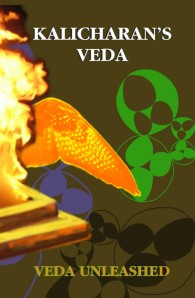
Running through the Veda, both integrally and differentially, and showing itself as an exceptional, yet natural, body from which all the subsequent belief-systems are seen to be rather derived, than induced, this superstructure also finds its unbroken chain of validations in the Yogic practices and other living mechanisms such as the Sacred-thread, Gayatri-mantra, etc.
The real contemporary and revelatory message that this book sends out (without being preachy or explicit), though, is to the class of earnest, working professionals in India (in Scientific, Artistic, Engineering, Managerial and Social fields) who, without exception, fall sandwiched between the seemingly impossible heights of perfections of the Western world on one hand, and the invisible, inscrutable ground of their own Cultural-context on the other (the plenitude of corruption and gurus doesn’t help).
The problem, in decoding the Veda, that has continued perennially is that, given the highly non-linear mode of thought in the Rig Veda, you either totally miss the plot or get it all- in a flash.
“Kalicharan’s Veda” means that flash- it means that point of discontinuity (much needed too at this hour) in the flow and schemes of things – a spark anticipating triggered changes in various spheres, in unfathomable ways.

